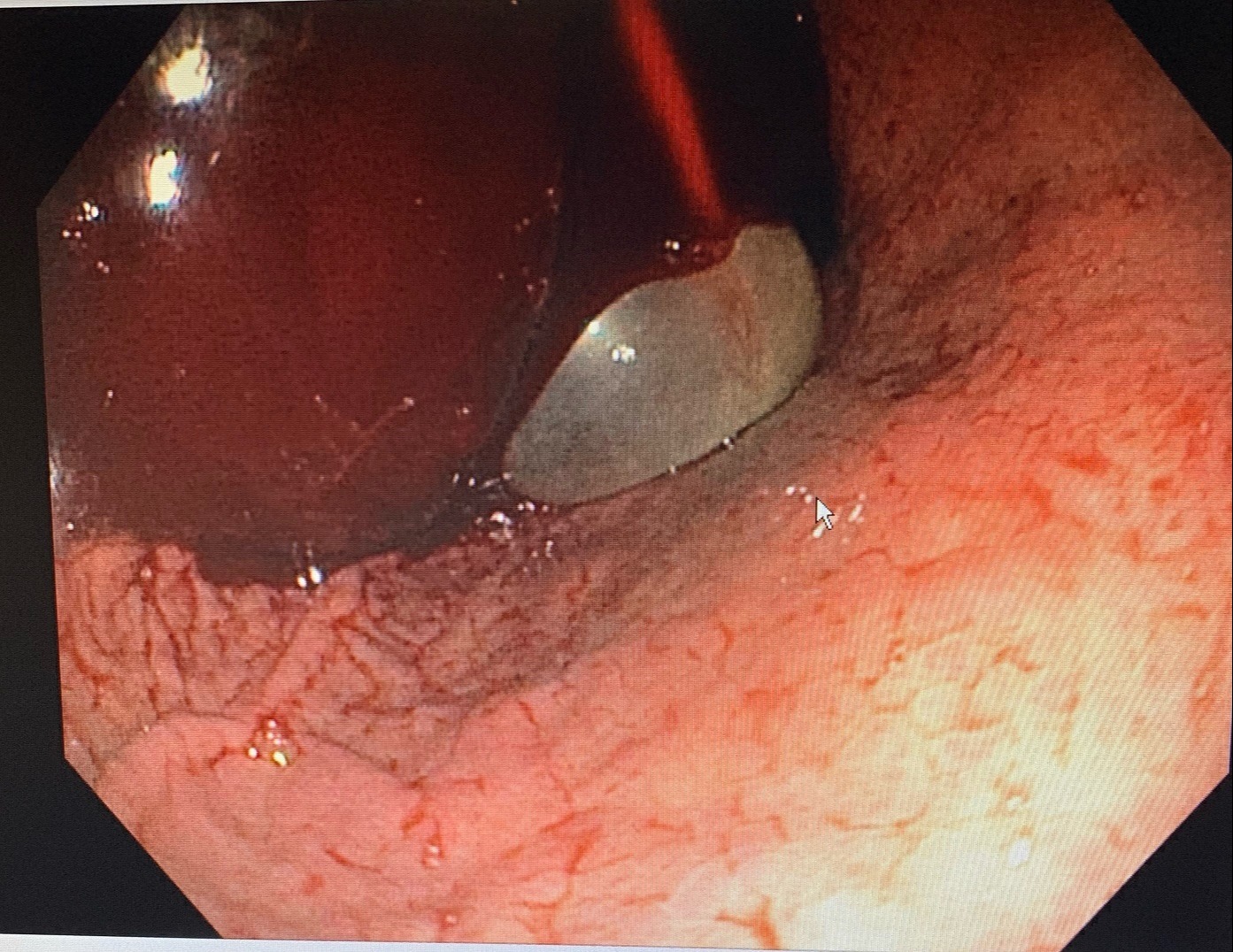Back
Poster Session A - Sunday Afternoon
A0306 - Endoscopic Sengstaken-Blakemore Tube Placement for Variceal Hemorrhage: A Case Series
Sunday, October 23, 2022
5:00 PM – 7:00 PM ET
Location: Crown Ballroom

Hadiatou Barry, MD, MPH
Creighton University/St. Joseph Hospital and Medical Center
Abington, PA
Presenting Author(s)
Hadiatou Barry, MD, MPH, Matthew Barvo, MD, Chinonso Ilo, MD, Mustafa Alani, MD, Kayvon Sotoudeh, MD, Brett Hughes, MD, Aida Rezaie, MD, Keng-Yu Chuang, MD, Subhash Chandra, MD
Creighton University, Phoenix, AZ
Introduction: Management of brisk variceal bleeding is challenging and nerve-racking for both gastroenterologists and intensivists. When visibility is hampered, a Sengstaken-Blakemore (SB) tube is used to tamponade as a temporary bridge to Transjugular intrahepatic portosystemic shunt (TIPS). Traditionally, the SB tube is placed blindly, or with the help of radiography to confirm gastric balloon location. Catastrophic complications are reported with blind approach including distension of the esophagus or trachea leading to rupture. Endoscopic SB placement has been described in literature as a successful technique. We report 3 cases with successful placement of SB tubes in massive variceal hemorrhage as a bridge to TIPS.
Case Description/Methods: Case 1. A 36-year-old gentleman with alcoholic cirrhosis presented with hematemesis 2 days after undergoing variceal banding. Bleeding post-banding ulcers were confirmed with endoscopy and treated with hemoclips and epinephrine. Despite the intervention, the patient had recurrence of bleeding the following day with hematemesis. Repeat endoscopic intervention was limited due to poor visibility from brisk bleeding. An SB tube was placed endoscopically, and he underwent emergent TIPS that same day. The SB tube was removed 24 hours later with no recurrence of bleeding, and he was discharged to home.
Case 2. A 68-year-old gentleman with alcoholic cirrhosis and history of variceal bleeding presented with hematemesis. Emergency endoscopy found massive bleeding, however the source of bleeding could not be located. An SB tube was endoscopically placed and an emergent TIPS was performed on the same day. The SB tube was removed 24 hours later with no recurrence of bleeding. After a 10-day hospital stay, he was ultimately discharged to hospice.
Case 3. A middle-aged woman presented to the hospital with active variceal bleeding. She underwent successful endoscopic SB tube placement as a bridge to TIPS. Although she also had successful placement and no rebleeding, she ultimately succumbed to her disease.
Discussion: Endoscopic SB tube placement is an effective bridge to emergent TIPS due to the improved hemostasis and decreased likelihood of rebleeding. This technique also limits the complications of blind placement, such as inadvertently distending the gastric balloon in the wrong location. Therefore, gastroenterologists should consider endoscopic placement of a SB tube when other endoscopic interventions fail to achieve hemostasis in variceal hemorrhage.

Disclosures:
Hadiatou Barry, MD, MPH, Matthew Barvo, MD, Chinonso Ilo, MD, Mustafa Alani, MD, Kayvon Sotoudeh, MD, Brett Hughes, MD, Aida Rezaie, MD, Keng-Yu Chuang, MD, Subhash Chandra, MD. A0306 - Endoscopic Sengstaken-Blakemore Tube Placement for Variceal Hemorrhage: A Case Series, ACG 2022 Annual Scientific Meeting Abstracts. Charlotte, NC: American College of Gastroenterology.
Creighton University, Phoenix, AZ
Introduction: Management of brisk variceal bleeding is challenging and nerve-racking for both gastroenterologists and intensivists. When visibility is hampered, a Sengstaken-Blakemore (SB) tube is used to tamponade as a temporary bridge to Transjugular intrahepatic portosystemic shunt (TIPS). Traditionally, the SB tube is placed blindly, or with the help of radiography to confirm gastric balloon location. Catastrophic complications are reported with blind approach including distension of the esophagus or trachea leading to rupture. Endoscopic SB placement has been described in literature as a successful technique. We report 3 cases with successful placement of SB tubes in massive variceal hemorrhage as a bridge to TIPS.
Case Description/Methods: Case 1. A 36-year-old gentleman with alcoholic cirrhosis presented with hematemesis 2 days after undergoing variceal banding. Bleeding post-banding ulcers were confirmed with endoscopy and treated with hemoclips and epinephrine. Despite the intervention, the patient had recurrence of bleeding the following day with hematemesis. Repeat endoscopic intervention was limited due to poor visibility from brisk bleeding. An SB tube was placed endoscopically, and he underwent emergent TIPS that same day. The SB tube was removed 24 hours later with no recurrence of bleeding, and he was discharged to home.
Case 2. A 68-year-old gentleman with alcoholic cirrhosis and history of variceal bleeding presented with hematemesis. Emergency endoscopy found massive bleeding, however the source of bleeding could not be located. An SB tube was endoscopically placed and an emergent TIPS was performed on the same day. The SB tube was removed 24 hours later with no recurrence of bleeding. After a 10-day hospital stay, he was ultimately discharged to hospice.
Case 3. A middle-aged woman presented to the hospital with active variceal bleeding. She underwent successful endoscopic SB tube placement as a bridge to TIPS. Although she also had successful placement and no rebleeding, she ultimately succumbed to her disease.
Discussion: Endoscopic SB tube placement is an effective bridge to emergent TIPS due to the improved hemostasis and decreased likelihood of rebleeding. This technique also limits the complications of blind placement, such as inadvertently distending the gastric balloon in the wrong location. Therefore, gastroenterologists should consider endoscopic placement of a SB tube when other endoscopic interventions fail to achieve hemostasis in variceal hemorrhage.

Figure: Endoscopic placement of a SB tube, confirming correct placement for hemostasis
Disclosures:
Hadiatou Barry indicated no relevant financial relationships.
Matthew Barvo indicated no relevant financial relationships.
Chinonso Ilo indicated no relevant financial relationships.
Mustafa Alani indicated no relevant financial relationships.
Kayvon Sotoudeh indicated no relevant financial relationships.
Brett Hughes indicated no relevant financial relationships.
Aida Rezaie indicated no relevant financial relationships.
Keng-Yu Chuang indicated no relevant financial relationships.
Subhash Chandra indicated no relevant financial relationships.
Hadiatou Barry, MD, MPH, Matthew Barvo, MD, Chinonso Ilo, MD, Mustafa Alani, MD, Kayvon Sotoudeh, MD, Brett Hughes, MD, Aida Rezaie, MD, Keng-Yu Chuang, MD, Subhash Chandra, MD. A0306 - Endoscopic Sengstaken-Blakemore Tube Placement for Variceal Hemorrhage: A Case Series, ACG 2022 Annual Scientific Meeting Abstracts. Charlotte, NC: American College of Gastroenterology.
